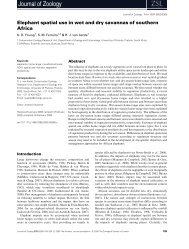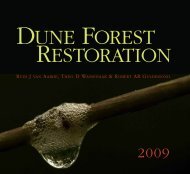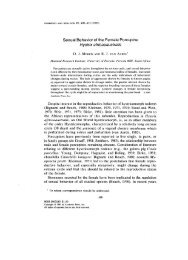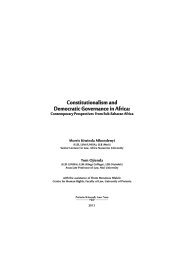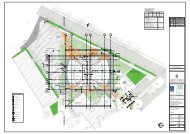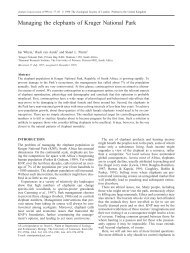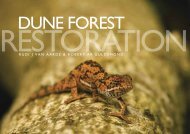Neighbourhood renewal in Cape Town's inner city: Is it gentrification?
Neighbourhood renewal in Cape Town's inner city: Is it gentrification?
Neighbourhood renewal in Cape Town's inner city: Is it gentrification?
You also want an ePaper? Increase the reach of your titles
YUMPU automatically turns print PDFs into web optimized ePapers that Google loves.
ISSN 0378-5254 Tydskrif vir Ges<strong>in</strong>sekologie en Verbruikerswetenskappe, Vol 28, 2000<br />
necess<strong>it</strong>y of residential succession or displacement of<br />
lower-class households. Studies based on this def<strong>in</strong><strong>it</strong>ion<br />
also <strong>in</strong>corporate upgrad<strong>in</strong>g of middle- or upper<strong>in</strong>come<br />
areas. These areas presumably cont<strong>in</strong>ue to be<br />
occupied by the same class, and thus the displacement<br />
cr<strong>it</strong>erion is e<strong>it</strong>her relaxed or ignored (Bourne, 1993).<br />
The choice of def<strong>in</strong><strong>it</strong>ion for this study is that of Bourne<br />
(1993) based on the urban change observed <strong>in</strong> London<br />
by Glass <strong>in</strong> 1964. This research was motivated by the<br />
displacement cr<strong>it</strong>erion for the chang<strong>in</strong>g and upgrad<strong>in</strong>g<br />
of older central urban areas.<br />
CAPE TOWN AS STUDY AREA: DATA AND<br />
VARIABLES<br />
The study was conducted (1995) <strong>in</strong> the residential<br />
neighbourhoods w<strong>it</strong>h<strong>in</strong> the municipal substructure<br />
“<strong>Cape</strong>” <strong>in</strong> the <strong>Cape</strong> Town metropol<strong>it</strong>an area. The substructure<br />
<strong>in</strong>cludes residential areas from Rugby <strong>in</strong> the<br />
north, M<strong>it</strong>chell's Pla<strong>in</strong> <strong>in</strong> the southeast and Bakoven <strong>in</strong><br />
the west. Ow<strong>in</strong>g to the size of the study area, only<br />
neighbourhoods w<strong>it</strong>h the potential of be<strong>in</strong>g gentrified<br />
were <strong>in</strong>cluded <strong>in</strong> the study. To identify residential areas<br />
w<strong>it</strong>h <strong>gentrification</strong> potential, the assistance of estate<br />
agents and town planners of the municipal<strong>it</strong>y of <strong>Cape</strong><br />
Town was enlisted. W<strong>it</strong>h their aid, six residential areas<br />
(De Waterkant, Bo-Kaap, Lower Gardens, Woodstock,<br />
Salt River and Walmer Estate), w<strong>it</strong>h<strong>in</strong> a radius of 4 km<br />
from the central bus<strong>in</strong>ess district (CBD) of <strong>Cape</strong> Town,<br />
were identified as potential <strong>gentrification</strong> areas (see Figure<br />
1). In De Waterkant, Bo Kaap, Lower Gardens and<br />
Walmer Estate the total residential area was <strong>in</strong>cluded <strong>in</strong><br />
the research, but <strong>in</strong> the case of Woodstock and Salt<br />
River only the areas south of Victoria Road were <strong>in</strong>cluded.<br />
In these two neighbourhoods urban <strong>renewal</strong><br />
was only noticeable <strong>in</strong> the higher ly<strong>in</strong>g areas w<strong>it</strong>h a view<br />
of the CBD and Table Bay.<br />
Ne<strong>it</strong>her the data from the 1991 nor the 1996 census<br />
could be used, because the boundaries for the census<br />
wards did not correspond w<strong>it</strong>h those of the residential<br />
areas <strong>in</strong> the study. The data for the study were obta<strong>in</strong>ed<br />
by means of a 10 % systematic sample questionnaire<br />
survey that was conducted <strong>in</strong> the six residential<br />
neighbourhoods. A questionnaire was completed for<br />
every tenth hous<strong>in</strong>g un<strong>it</strong> <strong>in</strong> all the streets w<strong>it</strong>h<strong>in</strong> the six<br />
neighbourhoods. In cases where the <strong>in</strong>formation was<br />
denied or contact w<strong>it</strong>h the <strong>in</strong>hab<strong>it</strong>ants of a hous<strong>in</strong>g un<strong>it</strong><br />
could not be established the adjacent un<strong>it</strong> was used. A<br />
total of 293 questionnaires were completed w<strong>it</strong>h<strong>in</strong> the<br />
study area. The survey obta<strong>in</strong>ed data concern<strong>in</strong>g the<br />
neighbourhoods and hous<strong>in</strong>g characteristics of these<br />
areas, as well as the personal and social characteristics<br />
of the residents.<br />
HISTORIC DEVELOPMENT AND URBAN RENEWAL<br />
IN CAPE TOWN<br />
Urban decay and <strong>renewal</strong> should be seen as byproducts<br />
of urban growth. The spatial transformation of<br />
the urban structure usually takes place <strong>in</strong> an unbalanced<br />
manner. The result is that growth areas will de-<br />
40<br />
velop at the expense of stagnant areas or even areas of<br />
decl<strong>in</strong>e. These areas of decl<strong>in</strong>e are usually problem<br />
areas of deterioration and blight that can develop <strong>in</strong><br />
older urban areas. Factors that will result <strong>in</strong> urban decay,<br />
are social disorganisation, changes to the population<br />
structure, lack of ma<strong>in</strong>tenance of build<strong>in</strong>gs, compet<strong>it</strong>ion<br />
w<strong>it</strong>h other land uses and irrational decision mak<strong>in</strong>g<br />
(Van der Merwe, 1989:137).<br />
Dur<strong>in</strong>g <strong>gentrification</strong> work<strong>in</strong>g-class neighbourhoods <strong>in</strong><br />
the <strong>in</strong>ner <strong>c<strong>it</strong>y</strong> are <strong>in</strong>vaded by people of the middle<br />
class w<strong>it</strong>h a higher <strong>in</strong>come, result<strong>in</strong>g <strong>in</strong> the replacement<br />
or displacement of many of the orig<strong>in</strong>al occupants.<br />
In this study the cond<strong>it</strong>ion of the neighbourhoods,<br />
their hous<strong>in</strong>g stock as well as their <strong>in</strong>hab<strong>it</strong>ants<br />
could not be tested <strong>in</strong> the past. To understand the process<br />
of urban <strong>renewal</strong> <strong>in</strong> <strong>Cape</strong> Town, <strong>it</strong> is necessary to<br />
study the development and the downgrad<strong>in</strong>g that took<br />
place <strong>in</strong> the <strong>c<strong>it</strong>y</strong>. Until the settlement of Europeans <strong>in</strong><br />
the <strong>Cape</strong>, the local population at the southern tip of Africa<br />
had no urban trad<strong>it</strong>ion (Lemon, 1991:1). W<strong>it</strong>h<strong>in</strong> 10<br />
years of Jan van Riebeeck's arrival <strong>in</strong> Table Bay <strong>in</strong><br />
1652, there were already elements of a town and the<br />
population grew to 394 (Cook, 1991:26), and because<br />
of this the Europeans, w<strong>it</strong>h their urban trad<strong>it</strong>ion, saw<br />
urban areas as their cultural doma<strong>in</strong> (Lemon, 1991:1).<br />
The settlement <strong>in</strong> Table Bay grew rapidly and dur<strong>in</strong>g the<br />
1806 Br<strong>it</strong>ish census <strong>it</strong> was found that 21 % of the <strong>Cape</strong><br />
Colony's population was liv<strong>in</strong>g <strong>in</strong> <strong>Cape</strong> Town and only<br />
39 % of them were of European descent. The urban<br />
character of <strong>Cape</strong> Town was already well established<br />
by 1855 w<strong>it</strong>h 3 891 houses and shops and a population<br />
of 25 189 (Cook, 1991:27). Metropol<strong>it</strong>an development<br />
<strong>in</strong> <strong>Cape</strong> Town started <strong>in</strong> 1861 when railway l<strong>in</strong>es to<br />
Wynberg and later to Muizenberg were built and Bellville<br />
was developed next to the ma<strong>in</strong> l<strong>in</strong>e to the <strong>in</strong>terior<br />
(Cook, 1991:27). Ow<strong>in</strong>g to the improved transport system,<br />
wealthier people started to leave District Six<br />
(presently known as Zonnebloem) and resettled <strong>in</strong><br />
Green Po<strong>in</strong>t and Sea Po<strong>in</strong>t. Because of the resettlement<br />
of these wealthy people, neighbourhood decay<br />
started <strong>in</strong> this older residential area between 1860 and<br />
1870 (Hart, 1988).<br />
Because of the dilapidated state of District Six and other<br />
older neighbourhoods <strong>in</strong> <strong>Cape</strong> Town, these areas became<br />
home to people of different race groups. W<strong>it</strong>h the<br />
outbreak of bubonic plague <strong>in</strong> <strong>Cape</strong> Town dur<strong>in</strong>g 1902,<br />
all black <strong>in</strong>hab<strong>it</strong>ants of the <strong>c<strong>it</strong>y</strong> were relocated to the N’dabeni<br />
township (Swanson, 1977). The process of decay<br />
<strong>in</strong> other old neighbourhoods of the <strong>c<strong>it</strong>y</strong>, for example De<br />
Waterkant that developed between 1793 and 1894, only<br />
started dur<strong>in</strong>g the twentieth century (Historiese De Waterkant<br />
verloor sy karakter nou v<strong>in</strong>nig, 1992).<br />
The urban <strong>renewal</strong> process <strong>in</strong> <strong>Cape</strong> Town started <strong>in</strong><br />
1966 after the <strong>in</strong>clusion of District Six as a Wh<strong>it</strong>e residential<br />
area under the Group Areas Act (Hart, 1988).<br />
Until 1978 a total of 33 446 official Coloured people, as<br />
well as an estimated 5 000 unlawful tenants were removed<br />
from this area, and most of the hous<strong>in</strong>g un<strong>it</strong>s of<br />
the neighbourhood were demolished (Cook, 1991:32).<br />
In De Waterkant the <strong>renewal</strong> process started <strong>in</strong> 1968<br />
<strong>Neighbourhood</strong> <strong>renewal</strong> <strong>in</strong> <strong>Cape</strong> Town’s <strong>in</strong>ner <strong>c<strong>it</strong>y</strong>: is <strong>it</strong> <strong>gentrification</strong>?






